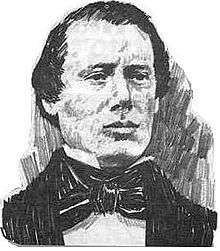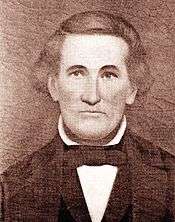Book of Mormon witnesses
| Part of a series on the |
| Book of Mormon |
|---|
 |
| Origin |
| Prophets and people |
| Historical authenticity and criticism |
|
|
The Book of Mormon witnesses are a group of contemporaries of Joseph Smith who said they saw the golden plates from which Smith said he translated the Book of Mormon. The most significant witnesses are the Three Witnesses and the Eight Witnesses, all of whom allowed their names to be used on two separate statements included with the Book of Mormon.
Three Witnesses
The Three Witnesses were a group of three early leaders of the Latter Day Saint movement who wrote in a statement of 1830 that an angel had shown them the golden plates from which Joseph Smith translated the Book of Mormon and that they had heard God's voice testifying that the book had been translated by the power of God.
The Three Witnesses were Oliver Cowdery, Martin Harris, and David Whitmer, whose joint testimony, in conjunction with a separate statement by Eight Witnesses, has been printed with nearly every edition of the Book of Mormon since its first publication in 1830. All three witnesses eventually broke with Smith and were excommunicated from the church.[1] In 1838, Joseph Smith called Cowdery, Harris, and Whitmer "too mean to mention; and we had liked to have forgotten them."[2] In 1839 Cowdery published a tract rejecting the Latter Day Saints and in 1840 become a member of the Methodist Protestant Church.[3] In later years, all three testified to the divine origin of the Book of Mormon and, at least near the end of their lives, all were members of one denomination or another of the Latter Day Saint movement. Harris and Cowdery rejoined The Church of Jesus Christ of Latter-day Saints shortly before their deaths, and Whitmer founded the Church of Christ (Whitmerite).
Eight Witnesses
The Eight Witnesses were the second of the two groups of "special witnesses" to the Book of Mormon's golden plates. They were all members of the Whitmer or Smith families: Christian Whitmer, Jacob Whitmer, Peter Whitmer, Jr., John Whitmer, Hiram Page, Joseph Smith, Sr., Hyrum Smith, and Samuel Harrison Smith. Joseph Smith Sr. was Joseph's father, and Hyrum and Samuel H. Smith were his brothers. Christian, Jacob, Peter Jr. and John were David Whitmer's brothers, and Hiram Page was his brother-in-law.[4]
Unlike the Three Witnesses, the Eight testified that they both saw and handled the plates. Another difference is that the Eight testified they were shown the plates by Joseph Smith rather than by an angel as had the Three Witnesses. Christian Whitmer died in 1835 and his brother Peter Whitmer, Jr. died the following year. In 1838, the surviving Whitmers became estranged from Joseph Smith during a leadership struggle in Far West, Missouri, and all were excommunicated with other dissenters,[5] never to rejoin Smith's church. None of the Eight Witnesses is known to have denied his testimony to the authenticity of Book of Mormon or the golden plates.
Another witness
Mary Musselman Whitmer (1778–1856), the mother of five Witnesses who took care of the household in Fayette, New York, where much of the translation occurred, said that an angel showed her the plates and thus made her more content to continue her daily labors.[6] Joseph Smith made no mention of this visitation in his journal.
Skeptical criticism of the Testimonies
Critics of the Latter Day Saint movement—from late nineteenth-century clergymen to Mark Twain to modern agnostics, evangelical Christians, and even some unorthodox ("Big Tent") Mormons—argue that the testimonies of the witnesses cannot be taken at face value.
- According to Grant Palmer, the Book of Mormon witnesses had a "nineteenth-century magical mindset" rather than "a rationalist perspective." They believed in what was called "second sight. Traditionally, this included the ability to see spirits and their dwelling places within the local hills and elsewhere."[7] A number of the witnesses possessed and used seer stones; Oliver Cowdery was a rodsman.[8] As Tufts University professor John L. Brooke has observed, many of the earliest Mormons were "very much attuned to the supernatural powers of witchcraft."[9] "Far removed from our own modern empiricism, the world view of the witnesses is difficult for us to grasp," and thus it is less impressive that "three signatories to the Book of Mormon saw and heard an angel."[10]
- All the witnesses were family, close friends, or financial backers of Joseph Smith. Cowdery, Page, and the five Whitmers were related by marriage.[11] Mark Twain later joked, "I could not feel more satisfied and at rest if the entire Whitmer family had testified."[12]
- Although Harris continued to testify to the truth of the Book of Mormon even when he was estranged from the church, at least during the early years of the movement, he "seems to have repeatedly admitted the internal, subjective nature of his visionary experience."[13]
- After Smith's death, James Strang, claiming to be Smith's chosen successor, also produced buried plates and the testimony of eleven witnesses to their authenticity. All living witnesses to the Book of Mormon (except possibly Cowdery)—three of the Whitmers, Martin Harris, and Hiram Page—accepted at least briefly Strang's "leadership, angelic call, metal plates, and his translation of these plates as authentic."[14]
Apologetic response
- LDS church leaders and student manuals note that none of the witnesses ever denied his testimony as it was printed in the Book of Mormon nor denied that Smith was a true prophet at the time he translated the book.[15]
- Apologists note that after being excommunicated, Harris and Cowdery later returned to the church.[16]
References
- ↑ "All three witnesses eventually quarreled with Joseph and left his church. At their going he heaped abuse upon them, but none ever denied the reality of his vision, and Cowdery and Harris eventually were rebaptized. Joseph had no fear in vilifying them; he neither expected nor received reprisals. For he had conjured up a vision they would never forget." Brodie (1971, p. 78)
- ↑ B. H. Roberts, ed. History of the Church (Salt Lake City: Deseret News, 1905), 3: 232.
- ↑ Charles Shook. The true origin of the Book of Mormon (Cincinnati: Standard Pub. Co., 1914), 49-61.
- ↑ Richard Lyman Bushman, Joseph Smith: Rough Stone Rolling (New York: Alfred A. Knopf, 2005), 79: "Critics pointed out how many of the witnesses were members of the Smith and Whitmer families, implying that they signed out of loyalty or from a self-serving motive....The witnesses were no substitute for making the plates accessible to anyone for examination, but the testimonies showed Joseph—and God—answering doubters with concrete evidence, a concession to the needs of post-Enlightenment Christians."
- ↑ Bushman, 337,339, 350-51. On June 17, Sidney Rigdon "preached a vitriolic sermon based on the theme of salt losing its savor and being cast out and trodden underfoot....Soon after the sermon, eighty-three prominent members in Far West, many of them probably Danites by then, signed an ultimatum demanding the departure of the offenders....Fearing for their property and perhaps their lives, the dissenters fled." (355-51) In 1847, David, John, and Jacob Whitmer and Hiram Page were baptized into the newly formed Church of Christ founded by William E. M'Lellin. In 1831, Joseph Smith received a revelation from God that John Whitmer should "write and keep a regular history" of the church (D&C 47). Whitmer did eventually write such a history, but one which concluded with a detailed description of what Whitmer considered the mistreatment that he and his family had received in Caldwell County. See Bruce N. Westerngren, From Historian to Dissident: The Book of John Whitmer (Salt Lake City: Signature Books, 1995).
- ↑ "David Whitmer Interview with Edward Stevenson, 9 February 1888,"in Dan Vogel, Early Mormon Documents (Salt Lake City: Signature Books, 2003), 5: 160-61; John C. Whitmer Interview with Andrew Jenson and Edward Stevenson, 11 October 1888," in EMD 5: 260-62. John Whitmer said that his grandmother always referred to the supernatural visitor as "Brother Nephi."
- ↑ Grant H. Palmer, An Insider's View of Mormon Origins (Salt Lake City: Signature Books, 2002), 175. Palmer devotes an entire chapter to the magical mindset of the Book of Mormon Witnesses.
- ↑ D. Michael Quinn, Early Mormonism and the Magic World View (Salt Lake City: Signature Books, 1998), rev. ed., 239-40.
- ↑ John L. Brooke, The Refiner's Fire: The Making of Mormon Cosmology, 1644-1844 (New York: Cambridge University Press, 1994), 77.
- ↑ Palmer, 194-95.
- ↑ Palmer, 179.
- ↑ Quoted in Fawn Brodie, No Man Knows My History: The Life of Joseph Smith (New York: Alfred A. Knopf, 1986), second ed., 79.
- ↑ Vogel, Early Mormon Documents, 2: 255. The foreman in the Palmyra printing office that produced the first Book of Mormon said that Harris "used to practice a good deal of his characteristic jargon and 'seeing with the spiritual eye,' and the like." Pomeroy Tucker, Origin, Rise, and Progress of Mormonism (New York: D. Appleton and Co., 1867), 71 in EMD, 3: 122. John H. Gilbert, the typesetter for most of the book, said that he had asked Harris, "Martin, did you see those plates with your naked eyes?" According to Gilbert, Harris "looked down for an instant, raised his eyes up, and said, 'No, I saw them with a spiritual eye." John H. Gilbert, "Memorandum," 8 September 1892, in EMD, 2: 548. Two other Palmyra residents said that Harris told them that he had seen the plates with "the eye of faith" or "spiritual eyes." Martin Harris interviews with John A. Clark, 1827 & 1828 in EMD, 2: 270; Jesse Townsend to Phineas Stiles, 24 December 1833, in EMD, 3: 22. In 1838, Harris is said to have told an Ohio congregation that "he never saw the plates with his natural eyes, only in vision or imagination." Stephen Burnett to Lyman E. Johnson, 15 April 1838 in EMD, 2: 291. A neighbor of Harris in Kirtland, Ohio, said that Harris "never claimed to have seen [the plates] with his natural eyes, only spiritual vision." Reuben P. Harmon statement, c. 1885, in EMD, 2: 385.
- ↑ Palmer, 212-13.
- ↑ See, e.g., Dallin H. Oaks, "The Witness: Martin Harris", Ensign, May 1999; James E. Faust, "A Growing Testimony", Ensign, November 2011; Henry B. Eyring, "An Enduring Testimony of the Witness of the Prophet Joseph", Liahona, November 2003;"Lesson 4: Remember the New Covenant, Even the Book of Mormon", Doctrine and Covenants and Church History: Gospel Doctrine Teacher's Manual (1999).
- ↑ A list of articles is available in the FAIR Topical Guide, under Book of Mormon Witnesses Archived July 25, 2008, at the Wayback Machine.. See also FARMS search results: Three Witnesses Richard Lloyd Anderson, Book of Mormon Witnesses






